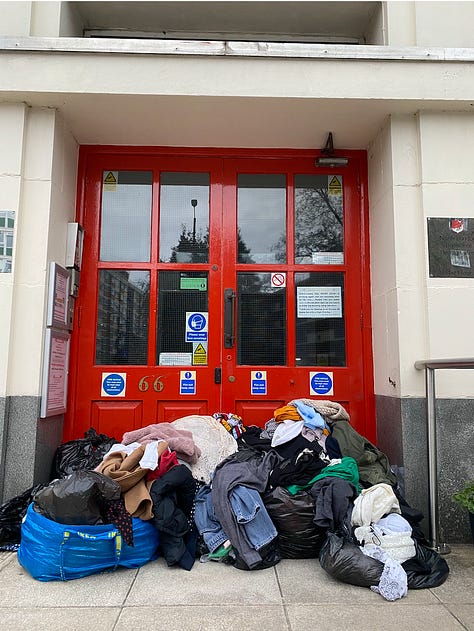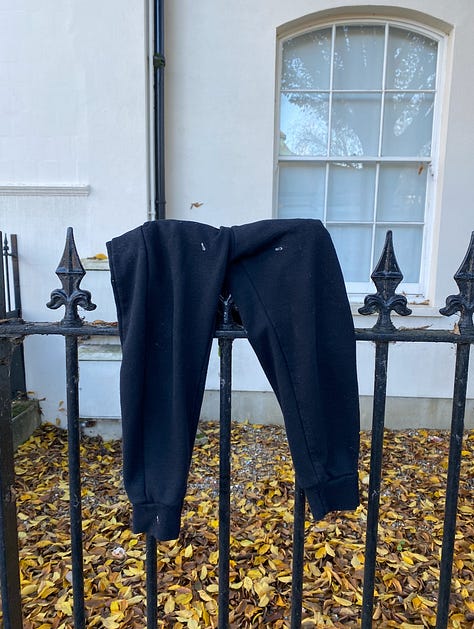What's the difference between sustainable fashion and slow fashion?
Aren't they the same thing really? That's what I thought, but researching this piece has made me wonder whether the slow fashion movement can be a stepping stone to a more sustainable fashion future?
Next week is busy! I've been invited to join two panel discussions talking about sustainable fashion, and I’m moderating a conversation about the slow style revolution. As I’ve been preparing for the questions I’m likely to be asked, and researching the questions I’d like to ask, I’ve been thinking about the differences, and similarities, between sustainable fashion and slow fashion.
Let’s start with sustainability?
I worry that the term sustainability has been so overused, and misused, that many of us have forgotten what it really means. What do you think?
The UN defines sustainability as meeting our needs in the present without compromising the ability of future generations to meet their own needs.
Take a moment and think about that! The elephant in the room is that the way many of us live our lives, particularly in the Global North, is totally unsustainable. Earth Overshoot Day marks the date when we humans have consumed all the natural resources that the planet is capable of regenerating in any given year - and in 2024 the UK’s overshoot day will be June 3rd. That means if everyone lived like us, we would need two and a bit planets to support us.
Is fashion sustainable?
I’ve read that the last time the fashion industry, and our apparel consumption, was at a sustainable level was in the 1980’s, or maybe the 1990’s. Since the turn of the century the Ellen MacArthur Foundation say the number of clothes being produced has more than doubled.
The number of clothes being produced every year is somewhere between 80 and 150 billion items. Although, as The Or Foundation’s Speak Volumes Campaign points out, most fashion brands don’t report on how many clothes they make.
Many brands now deliver new styles weekly, or even daily, and promote a constant flow of ‘must haves’ and ‘micro trends’ that are designed to keep us shopping. Here in the UK we’re buying four times as many clothes as we did in 2000 and wearing our clothes a lot less. Research by ReLondon revealed that in 2019 the average Londoner bought 48 items of new clothing and discarded 44 items, and Wrap estimates we put almost half (49%) of all our used textiles straight into the bin.



Despite the fact that the textile recycling industry is centuries old, according to the European Parliament only 1% of our old clothes are recycled into new textiles.
And that matters because 70% of the environmental impact of the clothes we wear happens during the manufacturing process. Making clothes is really resource intensive, with the fashion industry accounting for 10% of all carbon emissions, 20% of industrial water pollution globally, and around 700 million barrels of oil are used to make the polyester clothes we buy which could take over 200 years to biodegrade.
And the fashion industry wants to keep growing, which could see global apparel production numbers growing 63% by 2030. It’s just not sustainable!
So, what would a sustainable fashion industry look like?
Protecting the planet for future generations and making a sustainable fashion industry will likely involve - radical cuts in overall carbon emissions to align with the commitments in the Paris Climate Accord, reducing pollution, using far fewer pesticides and insecticides, providing visibility along the entire supply chain, addressing overconsumption and overproduction, reducing pre and post consumer waste, increasing recycling and reuse options, ensuring all garment workers are paid a fair wage that they can live on, respecting animal welfare and protecting biodiversity.
This will involve big changes in the way many businesses operate and as the latest Remake Fashion Accountability Report - 2024 says this will only happen if big brands “support legislation and binding agreements that hold fashion companies themselves mutually accountable for the human rights and environmental impacts along their supply chains.”
Legislation is being worked on; the EU are developing a strategy for sustainable and circular textiles, France has introduced what Vogue Business describes as “anti fast fashion” legislation, and in the US the California Garment Worker Protection Act became law in 2022, and the New York Fashion Act and the Fabric Act are in the pipeline. Theoretically that’s good news, but drafting legislation and changing business models takes time that people, and the planet, just don’t have.
So, could slow fashion be the answer?
The term slow fashion was first used by Kate Fletcher in 2007 in a article comparing ethical fashion with the slow food movement in The Ecologist. The grassroots slow food movement was founded in Italy in the 1980’s and promotes responsible consumption, asking consumers to be aware of the ethics, sustainability, quality and provenance of the food they eat.
Good on You say the slow fashion movement asks people, and businesses, to consider the people, processes and resources used to make our clothes, to reduce our consumption by focusing on buying fewer, better quality items that we are prepared to care for, rewear, repair, and to dispose of them responsibly when we no longer want them.
Whilst there are plenty of slow fashion brands who seek to manufacture locally, ethically and sustainably, what really interests me about slow fashion is that it’s something we can do as individuals too, while we’re waiting for all that legislation to kick in.
I understand people might be sceptical about big businesses ever changing, but I don’t think we should underestimate our power as a consumers. Brands watch, and react to, what people buy on a daily basis. If we all stopped buying polyester, businesses might try and persuade us to change our minds with marketing or discounts, but in the end I think they’d probably stop producing polyester? I think our choices really do matter!
What do you think?
Can conscious consumerism make a difference?
The idea of conscious consumerism started in the 1970’s and, put simply, it means trying to buy what you need as responsibly, ethically and sustainably as you can, while trying to shop local and support businesses, and people, that align with what’s important to you as an individual.
I’ve been trying to be a more conscious fashion consumer for the last five years and I’m still learning. It’s not easy! You can’t buy your way to a sustainable wardrobe and the first questions I ask myself are do I really need this or do I love it so much I’m going wear it lots, and keep wearing it and repairing it for a really long time.
If the answer’s yes - then I start asking more questions! What’s it made of? Was it responsibly and ethically sourced? I look up brands on the Good on You app or the Remake Fashion Accountability report. If I can’t find the answers to my questions - I email the brand and ask them directly. If they’re not prepared to answer me - that might be the answer I’m looking for.
What about choosing secondhand over new?
Being a conscious consumer also means taking the time to see if I can find what I’m looking for secondhand instead of new. In my opinion buying preloved apparel is probably the most sustainable and cost effective option open to us as consumers. Check apps like Vinted, DePop, and The Vestiaire Collective, as well as your local charity shops - there are literally millions of preloved treasures out there waiting to be found.
On Vinted today there are 133k Ganni items, 1.5 million Carhartt items, 6.3 million Levi’s items, 19.1 million Adidas items, and 59.4 million items from Zara.
It’s also worth checking what’s in your own wardrobe! Do you already own something similar that you could alter, repair or repurpose?
It all makes a difference
In their report London’s Fashion Footprint ReLondon estimate that if Londoners replaced a quarter of their new apparel purchases with secondhand and repaired 5% of their clothes so they could continue wearing them for longer it could reduce London’s fashion related emissions by 30%.
And that gives me the hope that we, as consumers, can build a slower, more sustainable fashion industry from the ground up.
What do you think?
I’m here to learn and I’d really like to know whether you think slow fashion, or conscious consumerism, or both can be stepping stones to a more sustainable fashion future?
Or come and join the conversation in person at one of the events below
6th June 5.30pm “Is there such a thing as sustainable fashion” at Canary Wharf
7th June 6.30pm “The Women Powering the Slow Style Revolution” in Stoke Newington
8th June 11am “Sustainable Style: Transforming the Fashion Industry in 2024” in St Albans




It’s really scary isn’t it! The interesting thing is that if you check out the site there are lots of countries that are even earlier than the UK and other countries who live ‘one planet lifestyles’ too. We lived a one planet lifestyle in the 80’s apparently so it is possible - if that makes any sense? And that’s what keeps me hopeful x
Hi Gem,
Great post again.
I've been reading around sustainability for my own research and there is a developing argument that being sustainable is no longer enough, we now need to be regenerative. We need to put back more than we take in one way or another because were are already using resources that future generations will need, which is a damning thought.
I think the area of slow fashion can often sit well with the home sewing community. Many people (myself included) like to take their time to make things and to add extra touches to personalise them. This isn't always the case as there are still plenty who 'fast sew', but I think if nothing else sewing makes you aware of how long it really takes to make a garment and to appreciate the skill needed to do so.